It’s a Cascade of 14nm CPUs: AnandTech’s Intel Core i9-10980XE Review
by Dr. Ian Cutress on November 25, 2019 9:00 AM ESTCPU Performance: Encoding Tests
With the rise of streaming, vlogs, and video content as a whole, encoding and transcoding tests are becoming ever more important. Not only are more home users and gamers needing to convert video files into something more manageable, for streaming or archival purposes, but the servers that manage the output also manage around data and log files with compression and decompression. Our encoding tasks are focused around these important scenarios, with input from the community for the best implementation of real-world testing.
All of our benchmark results can also be found in our benchmark engine, Bench.
Handbrake 1.1.0: Streaming and Archival Video Transcoding
A popular open source tool, Handbrake is the anything-to-anything video conversion software that a number of people use as a reference point. The danger is always on version numbers and optimization, for example the latest versions of the software can take advantage of AVX-512 and OpenCL to accelerate certain types of transcoding and algorithms. The version we use here is a pure CPU play, with common transcoding variations.
We have split Handbrake up into several tests, using a Logitech C920 1080p60 native webcam recording (essentially a streamer recording), and convert them into two types of streaming formats and one for archival. The output settings used are:
- 720p60 at 6000 kbps constant bit rate, fast setting, high profile
- 1080p60 at 3500 kbps constant bit rate, faster setting, main profile
- 1080p60 HEVC at 3500 kbps variable bit rate, fast setting, main profile
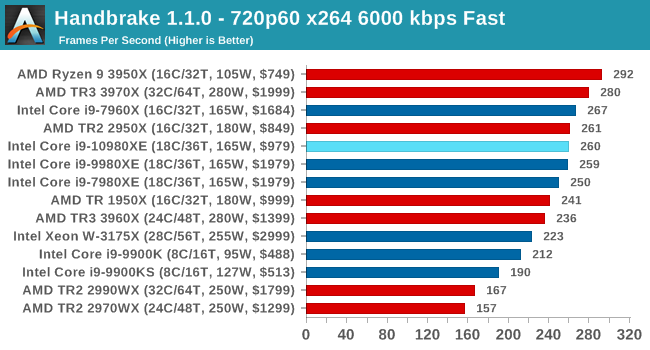
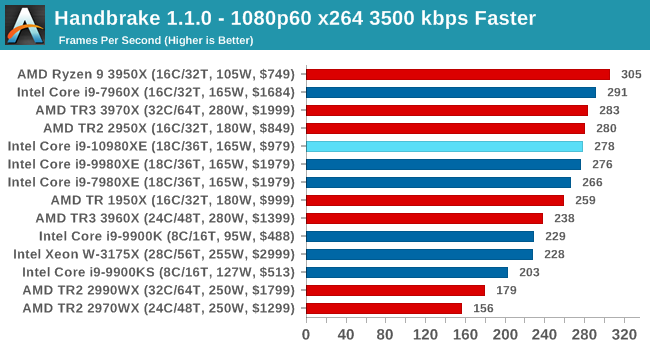
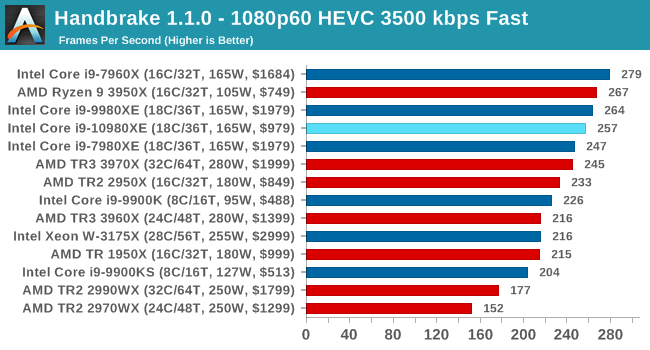
7-zip v1805: Popular Open-Source Encoding Engine
Out of our compression/decompression tool tests, 7-zip is the most requested and comes with a built-in benchmark. For our test suite, we’ve pulled the latest version of the software and we run the benchmark from the command line, reporting the compression, decompression, and a combined score.
It is noted in this benchmark that the latest multi-die processors have very bi-modal performance between compression and decompression, performing well in one and badly in the other. There are also discussions around how the Windows Scheduler is implementing every thread. As we get more results, it will be interesting to see how this plays out.
Please note, if you plan to share out the Compression graph, please include the Decompression one. Otherwise you’re only presenting half a picture.
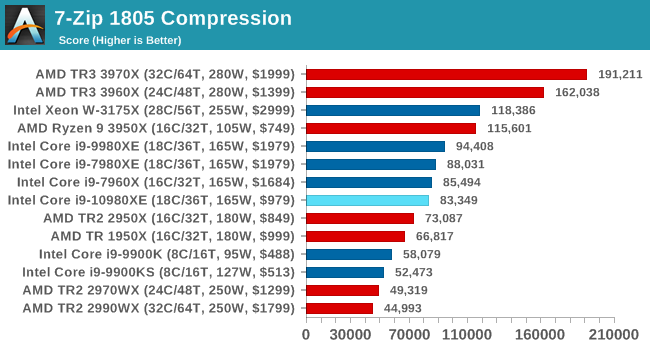
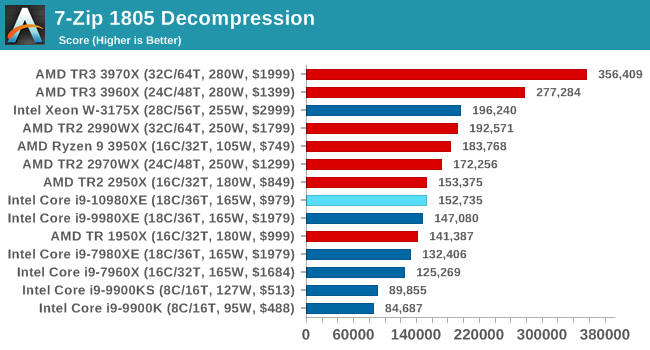
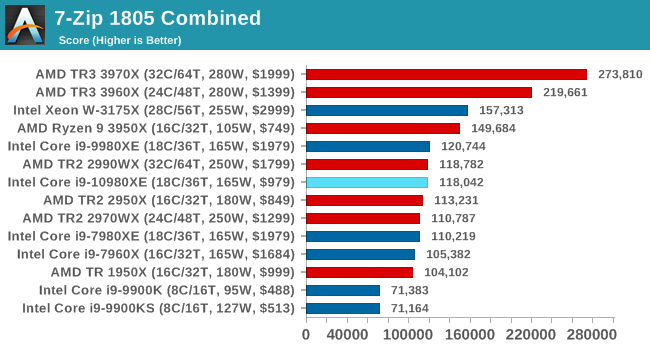
WinRAR 5.60b3: Archiving Tool
My compression tool of choice is often WinRAR, having been one of the first tools a number of my generation used over two decades ago. The interface has not changed much, although the integration with Windows right click commands is always a plus. It has no in-built test, so we run a compression over a set directory containing over thirty 60-second video files and 2000 small web-based files at a normal compression rate.
WinRAR is variable threaded but also susceptible to caching, so in our test we run it 10 times and take the average of the last five, leaving the test purely for raw CPU compute performance.
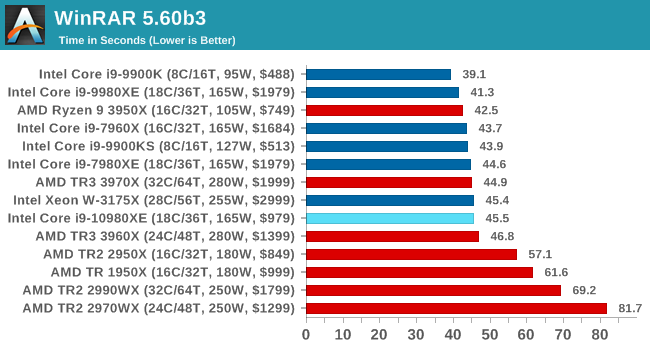
AES Encryption: File Security
A number of platforms, particularly mobile devices, are now offering encryption by default with file systems in order to protect the contents. Windows based devices have these options as well, often applied by BitLocker or third-party software. In our AES encryption test, we used the discontinued TrueCrypt for its built-in benchmark, which tests several encryption algorithms directly in memory.
The data we take for this test is the combined AES encrypt/decrypt performance, measured in gigabytes per second. The software does use AES commands for processors that offer hardware selection, however not AVX-512.
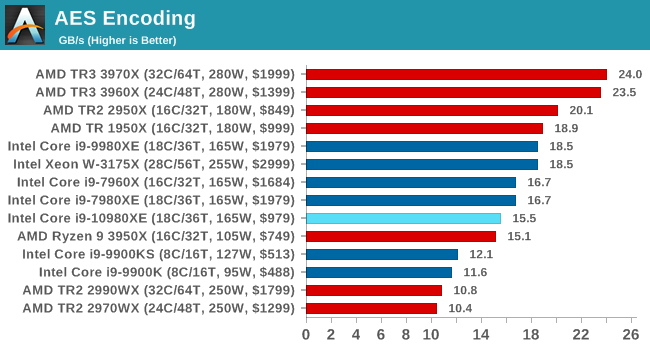
More than a slight regression here in our AES testing - this is probably the most severe of all our tests for how the security fixes have affected performance.










79 Comments
View All Comments
Santoval - Monday, November 25, 2019 - link
Wait for the prices of both to adjust first.Drumsticks - Monday, November 25, 2019 - link
I don't care about process nodes, as long as they're delivering competitive prices, core counts, and performance per core. Intel's not quite out of the game yet since AMD's HEDT goes higher than Intel's, but they've gotten smashed at the halo spot, and they won't be able to deliver on price and performance if they can't get something in order.Braincruser - Tuesday, November 26, 2019 - link
No they haven't been "smashed at the halo spot". The 3900X and 3950X are both beasts and both shred in most of the important benchmarks. For video rendering both the 3900x and 3950X hand out with both the threadrippers and the intels. You get 90% of the performance for 1/4th the price. 12-16 cores is also a very important number for programmers, since you have enough CPUs for compiling, and running 2-3 VMs comfortably.Dolda2000 - Monday, November 25, 2019 - link
Why is it that Intel gains so incredibly much more from AVX512 than AMD gains from AVX2?In the 3DPM2 test, the AMD CPUs gain roughly a factor of two in performance, which is exactly what I'd expect given that AVX2 is twice as wide as standard SSE. The Intel CPUs, on the other hand, gain almost a factor of 9, which is more than twice what I'd expect given that AVX512 as four times as wide as SSE.
What causes this? Does AVX512 have some other kind of tricks up its sleeves? Does opmasking benefit 3DPM2?
Xyler94 - Monday, November 25, 2019 - link
Basically, AVX-512 is double the performance of AVX2 (or another way to see it, 256bit vs 512bits, which 512 is double 256). So anything optimized for 512 will be about double in speed from 256, even on the exact same processor.Xyler94 - Monday, November 25, 2019 - link
To note: That's a highly overly simplistic view of it, there's a lot more under the hood.eek2121 - Monday, November 25, 2019 - link
Well that and the obvious point that AMD CPUs do not support AVX-512.DanNeely - Monday, November 25, 2019 - link
AVX-2 is 256 bits wide, and thus only does have as much/instruction as AVX-512.JayNor - Monday, November 25, 2019 - link
I believe for 10 cores and up there are dual avx512 units per core. You can see the dual avx512 units in the Execution Engine diagram at this link.https://en.wikichip.org/wiki/intel/microarchitectu...
Also, cascade lake added dlboost 8 bit operations in avx512 to support ai inference convolutions.
Dolda2000 - Monday, November 25, 2019 - link
But Zen 1/2 also has two 256-bit FMAs per core. And Intel also has two SSE units per core as well, so I don't see how that would explain the ratios.